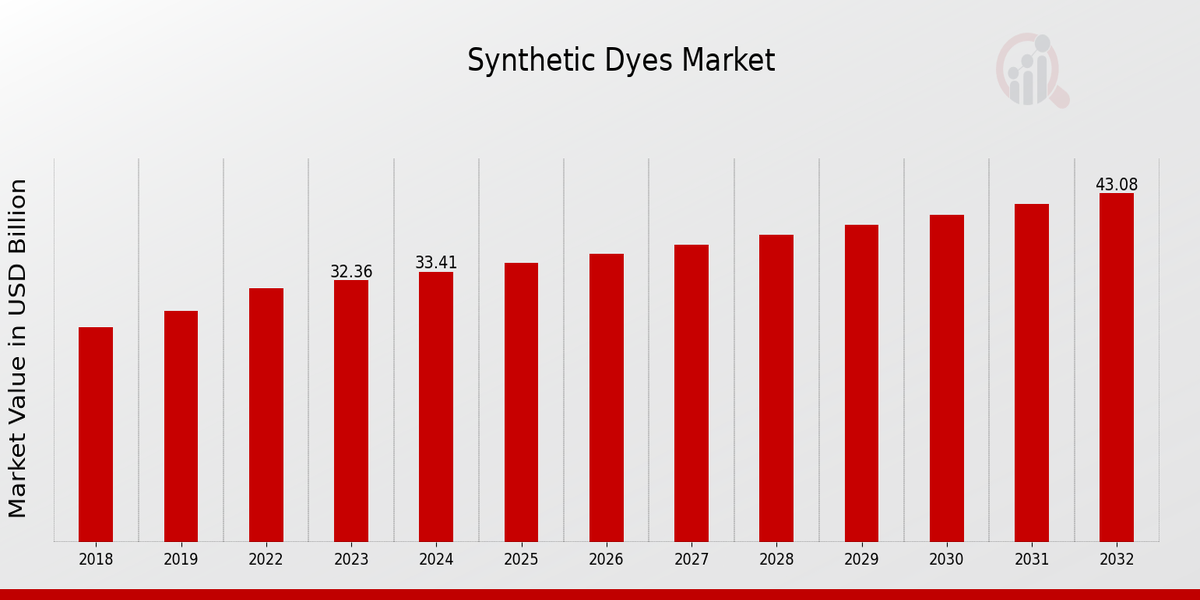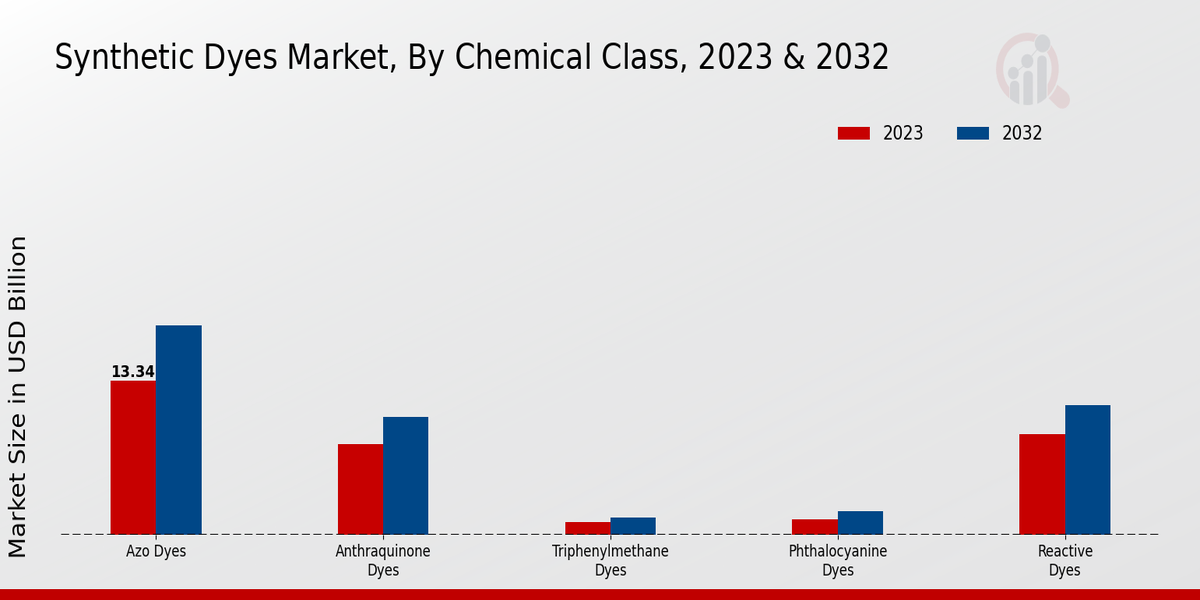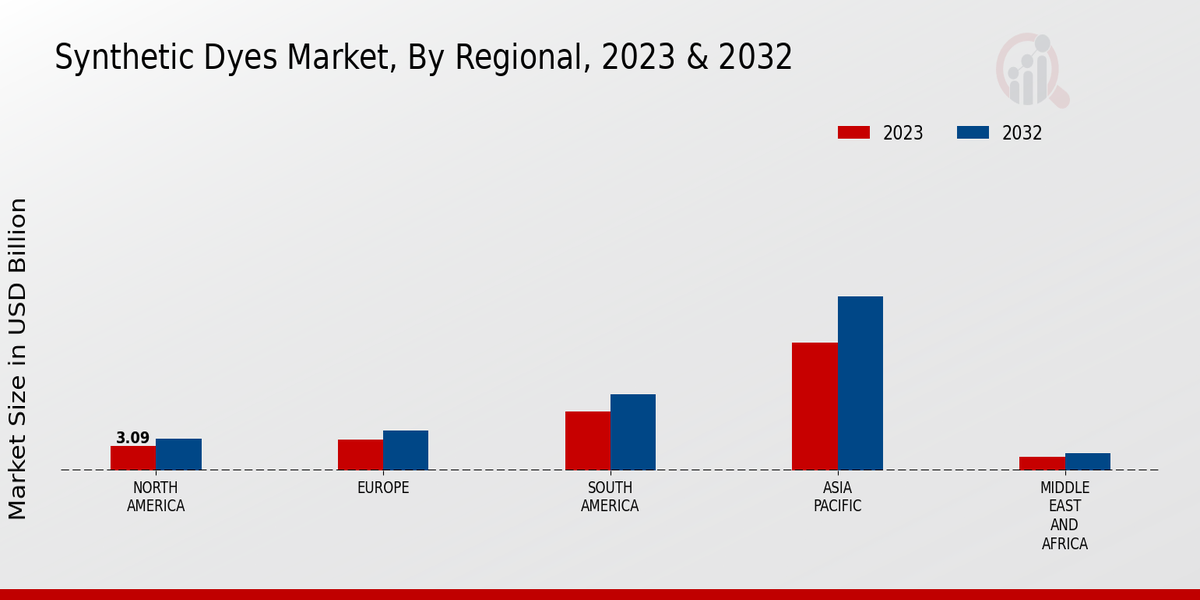Global Synthetic Dyes Market Overview
The Synthetic Dyes Market Size was estimated at 34.49 (USD Billion) in 2024. The Synthetic Dyes Industry is expected to grow from 35.6 (USD Billion) in 2025 to 47.41 (USD Billion) by 2034. The Synthetic Dyes Market CAGR (growth rate) is expected to be around 3.23% during the forecast period (2025 - 2034).
Key Synthetic Dyes Market Trends Highlighted
Rapid urbanization and industrialization are driving the demand for synthetic dyes in construction, textiles, automotive, and other industries. The increasing need for eco-friendly and sustainable dyes is another key driver as consumers become more environmentally conscious. Moreover, advancements in technology, such as the development of water-based and solvent-free dyes, are expanding the application scope of synthetic dyes.Major opportunities lie in the growing demand from emerging economies, particularly in Asia-Pacific, where rapid industrialization and population growth are fueling demand. Technological advancements, including the adoption of digital printing techniques, are creating new opportunities for customized and personalized dyeing solutions. Additionally, the shift towards sustainable and eco-friendly dyes presents significant growth prospects.
Recent trends in the synthetic dyes market include the growing emphasis on sustainability, with a focus on developing environmentally friendly dyes with reduced toxicity and waste generation. The adoption of automation and digital technologies is also transforming the production and application processes, leading to increased efficiency and reduced costs. Moreover, the increasing use of synthetic dyes in high-value applications, such as cosmetics and pharmaceuticals, is expanding the market potential.
 Source: Primary Research, Secondary Research, MRFR Database and Analyst Review
Source: Primary Research, Secondary Research, MRFR Database and Analyst Review
Synthetic Dyes Market Drivers
Growing Demand from Textile Industry
The textile industry is one of the largest consumers of synthetic dyes, accounting for over 60% of the market. The growing demand for textiles from various end-use sectors, such as apparel, home furnishings, and industrial applications, is driving the need for synthetic dyes. Synthetic dyes offer vibrant colors, durability, and resistance to fading, making them ideal for a wide range of textile applications. The increasing production of textiles in emerging economies, coupled with rising disposable income and changing fashion trends, is expected to continue to fuel the demand for synthetic dyes in the coming years.
Expansion of Automotive Industry
The automotive industry is another major consumer of synthetic dyes, particularly for the coloring of plastics and other materials used in vehicle interiors and exteriors. The growing production of automobiles, especially in emerging markets, is creating a strong demand for synthetic dyes. Synthetic dyes provide the automotive industry with a wide range of color options and the ability to achieve specific color effects, such as metallic finishes and color-shifting effects. The increasing demand for customized and personalized vehicles is also driving the need for specialized synthetic dyes that can meet the specific color requirements of consumers.
Increasing Environmental Regulations
Worldwide, environmental regulations are getting more and more strict which requires synthetic dyes manufacturers to switch to sustainable and eco-friendly technologies. In fact, the development of eco-friendly synthetic dyes meeting environmental standards is currently one of the market’s driving factors. They are less toxic, have a lower impact on the environment and are more regulatory-compliant. However, the increasing demand on the consumers’ part is another important factor driving the growth of this market as more and more people get interested in environmental issues and the ecological effect of the products they consume
Synthetic Dyes Market Segment Insights
Synthetic Dyes Market Chemical Class Insights
The synthetic dyes market is segmented on the basis of the chemical class, which includes Azo Dyes, Anthraquinone Dyes, Triphenylmethane Dyes, Phthalocyanine Dyes, and Reactive Dyes. The Azo Dyes segment dominated the market and is anticipated to exhibit a high growth rate over the forecast period. Azo Dyes are widely used in textile, paper, leather, and food applications, among several others. The Anthraquinone Dyes segment is another major segment of the synthetic dyes market. Such dyes possess the attributes of excellent lightfastness and resistance to chemicals.Anthraquinone Dyes are used in several applications, including automotive coatings, plastics, and inks, among several others. The demand for these dyes is expected to remain strong over the foreseeable period due to increasing automobile production and a growing construction sector, among others. The Triphenylmethane Dyes segment is anticipated to grow at a high CAGR over the forecast period. These dyes are primarily used in the textile industry for dyeing silk, wool, and cotton, among several others. Triphenylmethane Dyes are popular and are in great demand due to their bright and clear colours and excellent wash fastness.An increase in the demand for high-quality textiles in the fashion and apparel sector is the key driver of this segment. The Phthalocyanine Dyes segment is anticipated to grow at a significant pace. These are high-performance dyes that exhibit excellent lightfastness, heat resistance, and chemical stability. Phthalocyanine Dyes can be broadly applied to the metal finishing, plastics, and printing ink fields, among several others. A surge in demand for materials that are durable and resistant to fading is likely to be the driver for this segment.The Reactive Dyes segment is broadly applied to cotton, rayon, and paper to dye them. Reactive Dyes form covalent bonds with the fibers, which results in better colour fastness. The demand for high-quality textiles and durable and deeply coloured home textiles in the fashion and apparel industry is the key driver for the growth of this segment. The Chemical Class segment is a key driver in the Synthetic Dyes Market. Due to the diverse applications in various end-use industries and a rising demand for high-quality, long-lasting, and durable materials, the segment is likely to grow at a high rate over the foreseeable period.
 Source: Primary Research, Secondary Research, MRFR Database and Analyst Review
Source: Primary Research, Secondary Research, MRFR Database and Analyst Review
Synthetic Dyes Market Application Insights
The application segment is vital for fostering the Synthetic Dyes Market. The Textiles segment is forecasted to be the leading one in the market, holding a great scope in 2023 and is expected to continue leading throughout its growth period. Such a tendency is enforced by the rising demand for synthetic dyes in the textile industry as they are used to manufacture clothes, home textiles, and industrial fabrics. The Paper segment is also important in the Synthetic Dyes Market; it has a great scope precipitated by the increasing need for quality and unique printing and packaging solutions.Synthetic dyes are widely used to manufacture packaging paper, cardboard, and other paper products as they make them colorful and enduring. The Leather segment is rapidly developing as leather products, such as bags, shoes, and accessories, are increasingly in demand as long-lasting fashion accessories. Synthetic dyes are used to sustain the evolving fashion trends as they embellish leather goods with stylish colors. The share of the Plastics segment is also significant, as synthetic dyes are widely applied in the production of plastic goods, such as toys, consumer electronics, and auto parts.Their vibrant and sophisticated colors are used to comply with the growing need to manufacture perfect-looking and appealing goods. The Food segment is likely to develop, as synthetic dyes are gradually applied in food processing and packaging to make food appealing and extend its shelf life, simultaneously meeting all the regulations.
Synthetic Dyes Market Form Insights
The Synthetic Dyes Market is segmented based on Form into Powder, Liquid, and Paste. The Powder segment held the largest market share in 2023, accounting for around 42.5% of the market. The liquid segment is expected to witness the highest CAGR of 3.7% during the forecast period. Powder dyes are preferred due to their ease of handling and storage. They are widely used in the textile industry for dyeing cotton, wool, and synthetic fibers. Liquid dyes have gained popularity in recent years due to their ease of application and ability to achieve vibrant colors.Paste dyes are used in specialized applications, such as printing and dyeing of leather and paper. The rising demand for synthetic dyes from the textile, paper, and plastics industries is driving the growth of the Synthetic Dyes Market. The increasing use of synthetic dyes in emerging economies, such as China and India, is further contributing to market growth. Technological advancements, such as the development of eco-friendly dyes, are also supporting market growth.
Synthetic Dyes Market End-Use Industry Insights
The Synthetic Dyes Market segmentation by End-Use Industry offers valuable insights into the demand for synthetic dyes across various industries. The automotive industry is projected to hold a significant share of the market in 2023, driven by the growing demand for colored vehicles and the need for high-quality paints and coatings. The construction industry is another key consumer of synthetic dyes, utilizing them for coloring building materials such as paints, tiles, and flooring. The electronics industry also relies on synthetic dyes for coloring electronic components and devices.The packaging industry uses synthetic dyes to enhance the visual appeal of packaging materials, while the healthcare industry employs them in medical devices, pharmaceuticals, and cosmetics. The growth of these end-use industries is expected to drive the Synthetic Dyes Market demand in the coming years.
Synthetic Dyes Market Regional Insights
The regional segmentation of the Synthetic Dyes Market offers insights into the market's geographical distribution and growth patterns. North America holds a significant market share due to the presence of major textile and apparel industries in the region. Europe is another key market, driven by stringent environmental regulations and a growing demand for eco-friendly dyes.
The Asia-Pacific region is projected to witness the highest growth rate, attributed to the rapidly expanding textile industry in countries like China and India. South America and MEA are emerging markets with potential for growth as the textile and apparel industries in these regions continue to develop. These insights are crucial for businesses operating in the Synthetic Dyes Market, enabling them to tailor their strategies to specific regional dynamics and capitalize on growth opportunities.
 Source: Primary Research, Secondary Research, MRFR Database and Analyst Review
Source: Primary Research, Secondary Research, MRFR Database and Analyst Review
Synthetic Dyes Market Key Players And Competitive Insights:
Major players in the Synthetic Dyes Market are adopting various strategies to strengthen their market position. These strategies include expanding their product portfolio, entering into strategic partnerships and acquisitions, and investing in research and development. Leading Synthetic dye market players are also focusing on increasing their production capacity to meet the growing demand for synthetic dyes. The Synthetic Dyes Market industry is expected to witness significant growth in the coming years, owing to the increasing demand from various end-use industries, such as textiles, paper, and plastics. The growing awareness about the harmful effects of natural dyes is also expected to drive the demand for synthetic dyes.BASF SE is one of the leading players in the Synthetic Dyes Market. The company offers a wide range of synthetic dyes for various applications, including textiles, paper, plastics, and leather. BASF SE is also a major supplier of intermediates for the production of synthetic dyes. The company has a strong presence, with manufacturing facilities in Europe, Asia, and the Americas. BASF SE is committed to sustainable development and has a number of initiatives in place to reduce its environmental impact.Huntsman Corporation is another major player in the Synthetic Dyes Market. The company offers a wide range of synthetic dyes for various applications, including textiles, plastics, and coatings. Huntsman Corporation has a strong presence, with manufacturing facilities in Europe, Asia, and the Americas. The company is also a major supplier of intermediates for the production of synthetic dyes. Huntsman Corporation is committed to innovation and has a number of research and development programs in place to develop new and improved synthetic dyes.
Key Companies in the Synthetic Dyes Market Include:
Synthetic Dyes Market Industry Developments
The market growth is primarily driven by increasing demand from the textile and automotive industries, where synthetic dyes are used for coloring fabrics and automotive parts. Furthermore, rising urbanization and disposable income in emerging economies are expected to fuel the demand for synthetic dyes in the coming years.Recent developments in the synthetic dyes market include the growing adoption of eco-friendly and sustainable dyes. Manufacturers are focusing on developing dyes that meet environmental regulations and reduce the environmental impact of the dyeing process. Additionally, advancements in digital printing technology are reducing the consumption of synthetic dyes in the textile industry, as digital printing allows for more precise and efficient application of dyes.
Synthetic Dyes Market Segmentation Insights
Synthetic Dyes Market Chemical Class Outlook
-
Azo Dyes
-
Anthraquinone Dyes
-
Triphenylmethane Dyes
-
Phthalocyanine Dyes
-
Reactive Dyes
Synthetic Dyes Market Application Outlook
-
Textiles
-
Paper
-
Leather
-
Plastics
-
Food
Synthetic Dyes Market Form Outlook
Synthetic Dyes Market End-Use Industry Outlook
-
Automotive
-
Construction
-
Electronics
-
Packaging
-
Healthcare
Synthetic Dyes Market Regional Outlook
-
North America
-
Europe
-
South America
-
Asia Pacific
-
Middle East and Africa
| Report Attribute/Metric |
Details |
| Market Size 2024 |
34.49 (USD Billion) |
| Market Size 2025 |
35.6 (USD Billion) |
| Market Size 2034 |
47.41 (USD Billion) |
| Compound Annual Growth Rate (CAGR) |
3.23% (2025 - 2034) |
| Report Coverage |
Revenue Forecast, Competitive Landscape, Growth Factors, and Trends |
| Base Year |
2024 |
| Market Forecast Period |
2025 - 2034 |
| Historical Data |
2020 - 2024 |
| Market Forecast Units |
USD Billion |
| Key Companies Profiled |
Merck, Zhejiang Runtu Group, Kowa American Corporation, Milliken, Huntsman, Clariant, Everlight Chemical, Pylam Products Company, Lanxess, DIC Corporation, DyStar, BASF, Keystone Aniline Corporation, Archroma, Sudarshan Chemicals |
| Segments Covered |
Chemical Class, Application, Form, End-Use Industry, Regional |
| Key Market Opportunities |
Growing demand in textiles and apparel industriesIncreasing use in plastics, paper and leather industriesRising consumer preference for eco-friendly dyesExpanding applications in the automotive and construction sectorsGrowth in emerging markets, especially AsiaPacific |
| Key Market Dynamics |
Increasing demand for synthetic textiles Growing environmental concerns |
| Countries Covered |
North America, Europe, APAC, South America, MEA |
Frequently Asked Questions (FAQ) :
The synthetic dyes market is valued at USD 35.6 billion in 2025.
The synthetic dyes market is projected to reach USD 47.41 billion by 2034.
The synthetic dyes market is expected to grow at a CAGR of 3.23% from 2025 to 2034.
Asia-Pacific is the largest consumer of synthetic dyes, accounting for over 50% of the market.
Textiles is the largest application segment for synthetic dyes, accounting for over 60% of the market.
Key competitors in the synthetic dyes market include Huntsman Corporation, Archroma, BASF SE, Clariant AG, and Lanxess AG
Key growth drivers of the synthetic dyes market include increasing demand from the textile industry, rising disposable income, and growing urbanization.
Key challenges facing the synthetic dyes market include environmental regulations, competition from natural dyes, and technological advancements.
Key trends shaping the synthetic dyes market include sustainable dyes, digital printing, and functional dyes.
Key opportunities for the synthetic dyes market include emerging markets, innovative applications, and strategic partnerships.






 Source: Primary Research, Secondary Research, MRFR Database and Analyst Review
Source: Primary Research, Secondary Research, MRFR Database and Analyst Review Source: Primary Research, Secondary Research, MRFR Database and Analyst Review
Source: Primary Research, Secondary Research, MRFR Database and Analyst Review Source: Primary Research, Secondary Research, MRFR Database and Analyst Review
Source: Primary Research, Secondary Research, MRFR Database and Analyst Review







